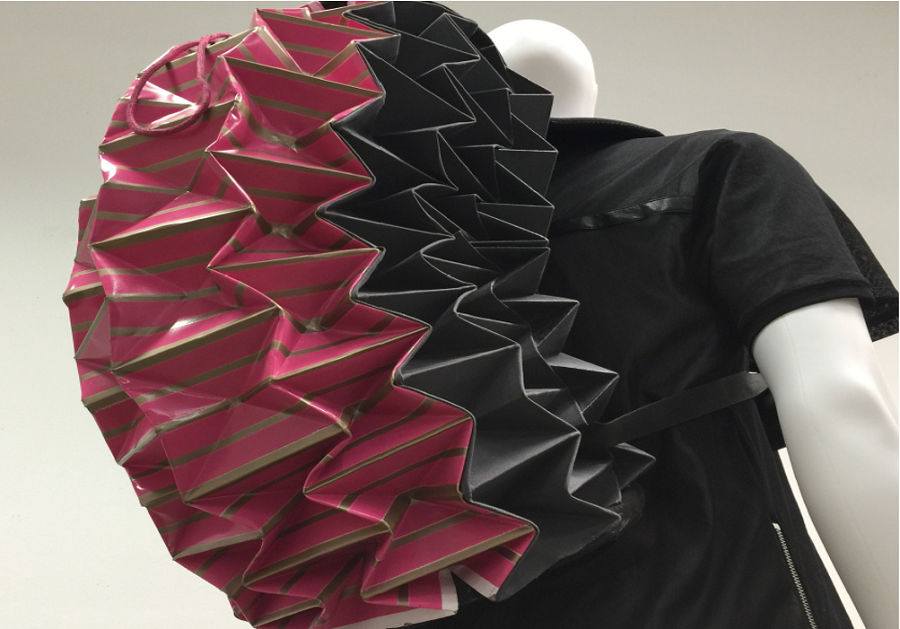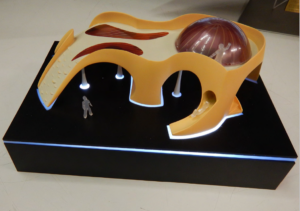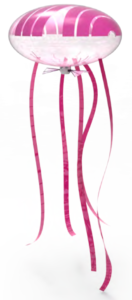We worked with Monash University Design students to test out our printed solar films - and their designs were out of this world!

One students creation: a solar backpack
A backpack created using our flexible solar panels.
When the scientific minds behind flexible solar panels got creative and printed a set of solar vertical blinds, there were cheers all around. But it was when they collaborated with Monash University industrial design students that the real celebrations started. The students got to work on cutting-edge technology, and the scientists who saw their work re imagined in ways they hadn’t even thought of.
Dr Fiona Scholes, whose team has been working on the development of printed solar films for almost a decade, said seeing the final seven designs the students came up with was breathtaking.
“The designs were so stunning and so well executed. Seeing the production quality, the finishes, the thought that had gone into each design and the attention to detail was quite overwhelming for me.”
Twelve weeks after giving the original brief to the students, Fiona and the team stood in the Monash University exhibition space packed with seven solar prototypes, from creatures to playgrounds, origami bags and plants.
Printing the sun
Imagine if solar panels were almost invisible. If you could buy them from the local hardware store and if you could roll them up to fit in your backpack.

One students creation: a solar playground
Fun in the sun – a solar playground designed by Monash University students.
We’ve created solar panels that are lightweight, flexible and printed directly onto plastic using a ‘solar ink’. Fiona described this amazing solar transformation as “[It’s] really just printing – but the ink is special because it absorbs light and turns it into electricity.”
“But the other thing you need is electrodes, so you do have to print connections as well as the solar ink.”
“One of the advantages of this kind of technology is the form factor. The look and feel of printed solar is completely different to conventional solar panels. There is a huge degree of design freedom there which is why we really wanted to engage designers.”
“By working with the designers we were able to take that leap and see what we needed to change in our lab to actually start producing something people really want,” Fiona said.
Solar creatures
Among a solar playground, backpack and bike charger, was the creation of a set of solar creatures that free roam the skies while harvesting energy from the sun. There’s the Solar Gatherer (Solaris Metentis) which hunts sunny spots in packs. A bit like a cat, the gatherer finds the best sunny spot in the area and then uses light to communicate and indicate energy status. It uses the energy it collects to move and communicate with other creatures.

Harry Holden's creation: a solar creature
Harry Holden’s solar creature design.
Then there is the Solar Stalker (Solaris Venator) which ensures no Gatherers are sleeping on the job, herding them to the sunniest of spots. Designer and creator of the Solar Creatures, Harry Holden, hopes his creatures invoke wonder in the passing population.
“I’d really love to see several of them bobbing around somewhere the public could really engage with the technology and see the potential of an energy efficient future,” he said.
And it would be fair to say that Harry became quite attached to his creation.
“While I put a huge amount of effort into mocking up the solar balloon (the final model actually flew), the small undercarriage and the ‘face’ of the creature was my favourite part. Each piece was necessary, all the functional electronics were included, and it had so much personality!”
And while the creatures may be a thing of the near future, Fiona has other places she would like to see the tech.
“I’d love to be on a tram along Swanston Street looking up at the skyscrapers and seeing every single surface of those buildings covered in it. At the moment we use such a small fraction of the available surfaces to collect sunlight and printed solar films are a way of using all that space.”


4th August 2016 at 3:29 pm
Is there any data; kW rating, effeciency, etc?
When will they be commercially available?
10th August 2016 at 5:36 am
These are non-working mockups for sure. The backpack is clearly printed on cardboard. Printed solar cells look more shiny/plastic (just check CSIROs work on that).
Efficiency is max 2-3% based on their scientific publications. The red color is typical for P3HT polymer and therefore not highly efficient.
If you look for commercially available organic solar cells look in Europe: Heliatek, infinityPV, Solarte.
11th August 2016 at 8:41 am
Hi Russell,
Solar inks are showing promise to be almost as efficient as silicon, but we still have some way to go to demonstrate this on a large, flexible films.
Lower efficiency printed solar films may be commercially available sooner.
Cheers,
Ellen
CSIRO Social Media
4th August 2016 at 2:55 pm
love the back-pack, can there be more “squarish” ones to suit laptops?
11th August 2016 at 8:40 am
Hi Dirk,
An overseas company has made a commercial attempt with a laptop bag at the very early stage of the technology. The model was not as stylish as the solar-gami back-pack though.
These are only concepts at this stage, of what the technology could look like in the future.
Cheers,
Ellen
CSIRO Social Media
28th July 2016 at 12:13 pm
Will the backpack be made available commercially, is there a timeframe? Thank you
27th July 2016 at 11:59 pm
In practical use, that is with solar radiation as input, what useful lifespan could be expected when using these ‘lnks’?
29th July 2016 at 1:02 pm
Hi Frank,
The inks are pretty robust as they have to survive temperatures above 100 degC as part of the printing process. We’ve had them in outdoor exposure studies for a few years now and they are still going strong!
Cheers,
Ellen
CSIRO Social Media
29th July 2016 at 11:49 pm
Thanks for your reply Ellen
It is great news that your system is so robust. I have no doubt that it will find many applications and will encourage a stream of inventions based on your work.
27th July 2016 at 3:23 pm
Awesome!